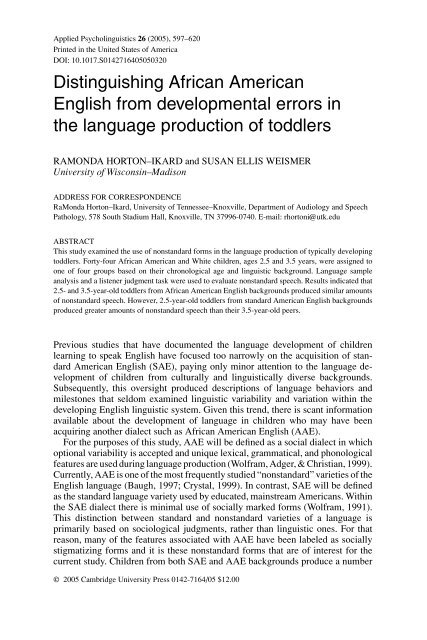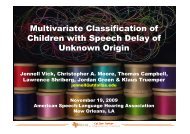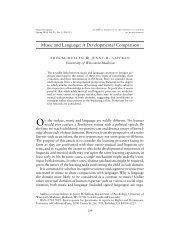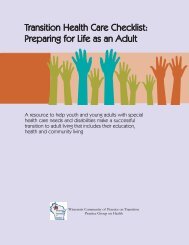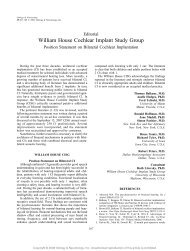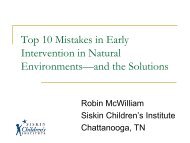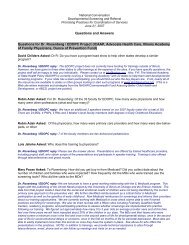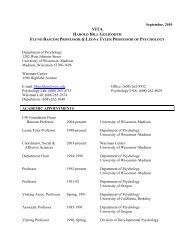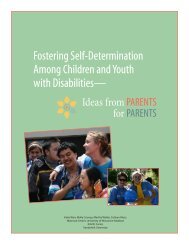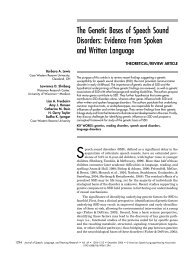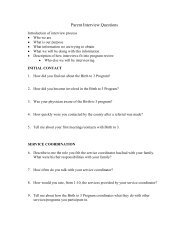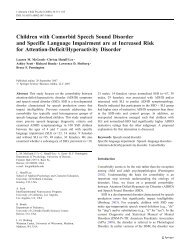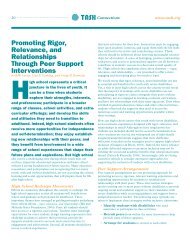Distinguishing African American English from developmental errors ...
Distinguishing African American English from developmental errors ...
Distinguishing African American English from developmental errors ...
Create successful ePaper yourself
Turn your PDF publications into a flip-book with our unique Google optimized e-Paper software.
Applied Psycholinguistics 26:4 598Horton–Ikard & Weismer: AAE versus <strong>developmental</strong> <strong>errors</strong>of nonstandard forms that do not follow the standard language variety spoken bymainstream adults. The focus of the present investigation is to determine whetherit is possible to distinguish between <strong>developmental</strong> <strong>errors</strong> that are common acrosschildren <strong>from</strong> different dialectal backgrounds and the early use of AAE vernacular.To date, there have been few reports that examine the development of thefeatures associated with AAE use in children. This problem persists even thoughit has been reported that a large segment of <strong>African</strong> <strong>American</strong> adults and childrenuse AAE (Dillard, 1972; Rickford, 1999; Wolfram et al., 1999). The examinationof variations within and across linguistic systems is especially importantfor research concerned with documenting the language development of children<strong>from</strong> linguistically diverse backgrounds. Inquiry about the course and sequenceof dialect development will play a significant role in future research that focuseson the evaluation and treatment of language disorders in populations who use adialect other than SAE.There are a substantial number of gaps in the literature on AAE use. Themajority of descriptions concerning the development of AAE forms have focusedprimarily on preschoolers and school-age children (Isaacs, 1996; Stockman,Vaughn–Cooke, & Wolfram 1982; Washington & Craig, 1994; Wyatt, 1991). Themost frequently cited studies of AAE use in toddlers or children below the ageof four remain unpublished (Blake, 1984; Cole, 1980; Reveron, 1978; Steffensen,1974). Many of the early investigations that did examine the use of AAE in childrenprimarily sought to discredit claims that described the language development andproduction of <strong>African</strong> <strong>American</strong> children as deficient and inferior. In discreditingthese claims it was necessary to highlight findings of similar linguistic behaviorsbetween <strong>African</strong> <strong>American</strong> and White children <strong>from</strong> SAE backgrounds; anydifferences that did appear were considered to be a simple byproduct of early<strong>developmental</strong> changes (Cole, 1980; Kovac, 1980; Stockman, 1986). Today it isrecognized that differences are not the same as deficits, and that linguistic andcultural differences do impact the development of language in a variety of ways.Recently, it has been suggested that children’s linguistic systems, howeverincomplete, are already adapted to the structural or statistical regularities of theirparent language by 24 months of age (Boysson–Bardies & Vihman, 1991; Ingram,1995). This incomplete, yet “culturally specific,” system is believed to providethe foundation for later grammatical development (Valian, 1999). A substantialnumber of <strong>African</strong> <strong>American</strong> parents and caregivers, who shape the linguisticenvironment of their children, use an adult form of AAE that differs in varyingdegrees <strong>from</strong> SAE. As a linguistic system in its own right, AAE tends to varyalong lexical, grammatical, phonological, prosodic, and discourse dimensions.This means that it is likely that children do demonstrate some dialect specificcharacteristics even during the earliest stages of language development.During the early years of development, children <strong>from</strong> AAE and SAE backgroundshave a tendency to produce similar unmarked forms that indicates acommon language-learning process. However, this common language-learningprocess does not nullify the possibility of differences. There are very few reportson the use of <strong>developmental</strong> <strong>errors</strong> that are similar to the features of AAE, such asvariable copula absence (e.g., “He fat”), that occur during the language productionof typically developing children who are <strong>from</strong> SAE backgrounds (Berko, 1958;
Applied Psycholinguistics 26:4 599Horton–Ikard & Weismer: AAE versus <strong>developmental</strong> <strong>errors</strong>Menyuk, 1964). In addition, there are no reports that have examined the useof AAE-like features, which have no equivalent SAE contrast (i.e., aspect andtense markers such as habitual be, go as copula) in young SAE speakers. Theprimary focus of most investigations has been on the acquisition of adultlike SAEforms (Brown, 1973; deVilliers & deVilliers, 1973; Lahey, Liebergott, Chesnick,Menyuk, & Adams, 1992). In essence, there are relatively few data concernedwith the study of AAE-like forms produced by young SAE speakers to support thenotion of similar <strong>developmental</strong> patterns and few differences in the early languageproductions of young AAE and SAE speakers. Given that there is such a limitedamount of research concerning the use of AAE forms during the toddler years itwould be premature to conclude that the use of linguistic forms typically associatedwith AAE are simply <strong>developmental</strong> <strong>errors</strong>.Lack of sufficient data on the language of young dialect users has a numberof implications. Clinically, the assessment and treatment of language disorders inspeakers who use a dialect such as AAE is compromised when empirical data arelimited (Seymour, Bland–Stewart, & Green, 1998; Stockman, 1996; Washington,1996). In addition, expanded descriptions of the language behaviors of youngAAE and SAE speakers can provide researchers with more information on thevariability of linguistic forms. Such information will be extremely useful for individualsconcerned with the construction of culturally fair assessment for children.In addition, continued examination of when AAE makes its first appearance inthe language of children can provide the field with more information regardingcultural influences upon the development of language (Stockman, 1996). If thereis evidence of early use of AAE, this might also suggest that there needs to besome specific and uniform resolution of public policy and educational practicesregarding the language of instruction for speakers for whom SAE is not theirmother tongue.RESEARCH QUESTIONSAAE and SAE dialects develop through children’s interactions with the ambientlanguage in their speech community. The purpose of this study was to determinethe point at which a distinction can be made between AAE and <strong>developmental</strong><strong>errors</strong>, given that the use of many “nonstandard” forms in early SAE mimic featuresof AAE. To determine if the use of these nonstandard forms was influenced bydialectal background or <strong>developmental</strong> factors the following questions were posed:1. Do toddlers <strong>from</strong> AAE backgrounds demonstrate quantitative differences intheir production of nonstandard forms compared to peers <strong>from</strong> SAE backgrounds?2. How does age influence production of nonstandard forms across backgrounds?3. Is there evidence of AAE use in the language production of 2.5- and 3.5-year-oldtoddlers based on listeners’ perceptions of their speech?4. What is the relationship between the production of nonstandard forms in spontaneousconversation and listeners’ perceptions of dialect usage?
Applied Psycholinguistics 26:4 600Horton–Ikard & Weismer: AAE versus <strong>developmental</strong> <strong>errors</strong>A comparative framework was employed to answer the questions about dialectalinfluences. Comparative frameworks used for the study of dialect in childlanguage have been justifiably criticized. Earlier investigations examining the languageabilities of <strong>African</strong> <strong>American</strong> children often characterized their languageand environmental input as deficient and inferior to that of their White peersor compared groups in which a large number of factors, such as socioeconomicstatus (SES), may have influenced the findings (Bereiter & Engelman, 1966; Orr,1984). As a result, an increasing number of studies have utilized designs in whichintragroup comparisons are made (Cole & Taylor, 1990; Stockman et al., 1982;Washington & Craig, 1994) when examining the language abilities of <strong>African</strong><strong>American</strong> children.However, it can be argued that comparative frameworks provide an effectivemodel for examining language variability and change. Empirical data <strong>from</strong> crossdialectalcomparisons may even prove to be beneficial in learning more aboutlanguage universals (Stockman, 1996). In particular, it has been asserted thatmany of the children who use AAE receive or will receive exposure to mainstreamSAE, so the use of a group of children who receive the maximum amount ofexposure to SAE is ideal for the purposes of this investigation.For the current study, it was predicted that effects for age and dialect statuswould influence the dialect measure obtained <strong>from</strong> language sample analyses.It was also expected that there would be a significant interaction between ageand dialect status, such that as age increases children in the SAE dialect statusgroup would demonstrate less use of the nonstandard forms typically associatedwith AAE. However, this trend was not expected for toddlers <strong>from</strong> the AAEdialect status group; in fact, their use of AAE dialectal features was expectedto increase with age. It was predicted that listeners would be able to accuratelyidentify race and dialect status for the majority of excerpts. In addition, it wasexpected that the mean ratings for AAE usage would be higher for toddlers <strong>from</strong>AAE backgrounds than for toddlers <strong>from</strong> SAE backgrounds. Listener judgmentswere expected to correspond to the production of AAE vernacular forms in thespontaneous language samples. Confirmation of one or more of these predicationswould suggest that, in addition to <strong>developmental</strong> processes, dialectal backgrounddoes influence the production of nonstandard speech during the toddler years.METHODParticipantsForty-four typically developing <strong>African</strong> <strong>American</strong> and White toddlers participatedin this investigation. Children were assigned to one of four groups based onchronological age and dialect status. Group 1 consisted of 11 2.5-year-old <strong>African</strong><strong>American</strong> toddlers <strong>from</strong> AAE backgrounds (M = 31.09 months, SD = 2.21), andGroup 2 consisted of 11 2.5-year-old White toddlers <strong>from</strong> SAE backgrounds(M = 31.09 months, SD = 1.30). Group 3 consisted of 11 3.5-year-old toddlers<strong>from</strong> AAE backgrounds (M = 42.27 months, SD = 1.19), and Group 4 consistedof 11 3.5-year-old toddlers <strong>from</strong> SAE backgrounds (M = 42.09 months, SD =.70).
Applied Psycholinguistics 26:4 601Horton–Ikard & Weismer: AAE versus <strong>developmental</strong> <strong>errors</strong>Table 1. Group means and standard deviations for the participant characteristics andlanguage abilities for the toddlers <strong>from</strong> <strong>African</strong> <strong>American</strong> <strong>English</strong> (AAE) and standard<strong>American</strong> <strong>English</strong> (SAE) backgrounds broken down by age group2.5-Year-Olds3.5-Year-OldsAAE Status SAE Status AAE Status SAE StatusM SD M SD M SD M SDChronological age(years) 31.09 2.21 31.09 1.30 42.27 1.19 42.09 0.70Maternal education(years) 13.63 1.74 14.18 2.13 14.36 2.29 14.72 1.90Auditory PLS-3 100.00 19.93 128.81 15.63 108.00 15.56 127.00 13.83Expressive PLS-3 100.18 16.08 125.63 14.96 108.36 15.65 122.90 15.73Bayley scores a .72 .17 .91 .07 .74 .13 .83 .12Note: PLS-3, standard scores on the Auditory and Expressive portions of the PreschoolLanguage Scale—3 (Zimmerman et al., 1999).a Proportion correct on nonverbal cognitive items <strong>from</strong> the Bayley Scales of InfantDevelopment (Bayley, 1993).Each child’s primary caregiver completed a background form that elicited informationabout medical and <strong>developmental</strong> history. Children with a suspected historyof hearing loss, chronic otitis media, or <strong>developmental</strong> disabilities were excluded<strong>from</strong> this study. All children who participated in this investigation passed therequired hearing screening. Hearing was screened using distortion product otoacousticemissions guidelines set forth by the Joint Committee on Infant Hearing(2000). Cognitive functioning was assessed based on children’s performance onnonverbal items <strong>from</strong> the Bayley Scales of Infant Development, second edition(Bayley, 1993). Language ability was assessed using the Preschool LanguageScales—3 (PLS-3) developed by Zimmerman, Steiner, and Pond (1992). All childrenparticipating in this study scored no lower than 1.25 SD below the mean fortheir age on both portions of this measure. Given the potential for cultural andlinguistic bias, a score no lower than 1.25 SD below the mean was considered tobe an adequate determination of normal range language performance.Each of the linguistic groups was matched as closely as possible within andacross age levels based on the distribution of maternal level of education, asmeasured by the number of years of schooling; this is an index of SES that hasbeen shown to be related to language development (Chapman, Schwartz, & Kay–Raining Bird, 1995; Hoff–Ginsberg, 1991). See Table 1 for a complete descriptionof participant characteristics and language ability. To ensure that differences inSES and chronological age were not responsible for differences in the amount andappearance of AAE features, group comparisons using independent sample t testswere carried out on these two variables among the four groups. The differencesin chronological age for the 2.5-year-old AAE and SAE groups and 3.5-year-oldAAE and SAE groups were not significant, t (20) = 0, p = 1, and t (20) =−436,
Applied Psycholinguistics 26:4 602Horton–Ikard & Weismer: AAE versus <strong>developmental</strong> <strong>errors</strong>p = .667, respectively. Differences in maternal level of education between the2.5-year-old AAE and SAE toddlers were not significant, t (20) = .655, p =.520, and the differences between the 3.5-year-old AAE and SAE toddlers werenot statistically significant, t (20) = .405, p = .690. In addition, there were nosignificant differences in maternal level of education among those 2.5- and 3.5-year-old toddlers <strong>from</strong> AAE backgrounds, t (20) =−.837, p = .413; or those2.5-year-old and 3.5-year-old toddlers <strong>from</strong> SAE backgrounds, t (20) =−.632,p = .534.Dialect status group, as assigned by the first author, was based on exposure toAAE and SAE, and determined by the following factors: parental dialect use; peerlanguage use; and daycare provider language use. Parents who demonstrated useof at least four AAE features (across phonological, morphological, and syntacticareas) during a 15-min parent–child language sample were considered to be AAEusers and their toddlers were assigned to the AAE status group. Parents whodemonstrated use of no more than one feature associated with AAE and theirtoddlers were assigned to the SAE status group.Within the context of this investigation, at least half of the children did attenddaycare, so a brief description of each daycare where these participants wererecruited is in order. The first daycare facility comprised <strong>African</strong> <strong>American</strong> staffmembers who were heavy AAE users with only the directors demonstrating codeswitchingabilities once they were interacting with “outsiders” or visitors. Thesecond daycare facility <strong>from</strong> which some of the participants were recruited wasmade up of a diverse group of White families <strong>from</strong> a variety of social backgrounds,with working class families being well represented.Data collectionA 15–20-min language sample was collected <strong>from</strong> each child during a semistructuredfree-play context. These samples involved interaction between each childand the examiner. The examiner who elicited language samples <strong>from</strong> childrenwith AAE backgrounds in the present study was an <strong>African</strong> <strong>American</strong> examinerwho used AAE. This same examiner “code switched” to the use of SAE whileeliciting language samples <strong>from</strong> children who were <strong>from</strong> SAE backgrounds. Codeswitching, in this instance, means that an SAE register was adopted and the examiner’sspeech included SAE grammatical and phonological forms, in addition toprosodic and acoustic characteristics. Materials for the free-play context consistedof a standard set of toys, including a dollhouse, its accessories, and family memberplay figures. Language samples were recorded using a Marantz audio-recorder,a SONY video recorder, lapel microphone worn by the examiner, and a PZMmicrophone placed at floor level (next to the participant) to enhance video soundrecording.ProcedureLanguage sample analysis. Language samples were orthographically transcribed<strong>from</strong> audiotapes using Systematic Analysis of Language Transcripts (SALT;Miller & Chapman, 2000). The transcribers involved with this project were
Applied Psycholinguistics 26:4 603Horton–Ikard & Weismer: AAE versus <strong>developmental</strong> <strong>errors</strong>graduate students in communicative disorders who had received training in the useof language sample analysis using SALT and had completed graduate courseworkin clinical phonetics. Prior to this investigation, these individuals had transcribeda substantial number of language samples involving toddlers and preschoolers(ages 2–4 years). The transcribers were not apprised of the research questions forthis study; furthermore, they were not familiar with the speakers and were onlygiven information related to age and gender of the child. Utterance segmentationwas based on standard SALT procedures, which define an utterance as a verbalproduction typically separated by pauses and/or intonation cues and allowing nomore than two independent clauses.Coding for features of AAE. Coders examined each of the completed samplesand assigned a feature type to each of the nonstandard forms based on a compiledlist of features typically associated with use of AAE that have been previouslyobserved in children 4 years of age or younger (see Appendix A). Coders weretrained in assigning AAE type codes by the first author during an earlier projectexamining AAE use in children (Horton–Ikard, Weismer, & Evans, 2001). Otherfeatures of AAE that appeared in the children’s language sample but had not beenpreviously examined for this age group were also noted (go as copula, got/has,and existential it/they). Frequencies of the various types of AAE features wereobtained to aid in the calculation of total number of features and dialect densityfor each child’s sample and transferred into a database for later statistical analyses.As samples were transcribed, each child’s transcript was marked for instances ofAAE morphosyntax and phonological form usage. Although there was no comprehensivephonological analysis completed for these samples, selected phonologicaltranscription was undertaken (orthographic transcripts were examined for wordsoriginally selected as demonstrating AAE phonological form usage, as well asopportunities for occurrence of the phonological features under investigation;see Appendix A). These utterances were then transcribed using broad phonetictranscription (IPA; Shriberg & Kent, 1995). The first author, who has clinicalexperience in the phonetic transcription of children’s conversational speech, thenlistened to each sample using the original orthographic transcript with the broadrepresentation as a guide and completed a more narrow transcription for wordscontaining the phonological features under investigation using procedures <strong>from</strong>Pollock and Meredith’s (2001) system for transcribing AAE phonological features.Language sample variables. Standard SALT measures and a dialect density ratewere obtained for each sample. Standard SALT measures include the calculationof mean length of utterance in words (MLUW), type-token ratio, and mean turnlength. The calculation of MLU involved the use of an analysis set that eliminatedsingle morpheme responses, yes/no acknowledgments and answers to questions,and responses to intonation prompts. Calculating utterance length in this fashioncontrolled for possible pragmatic and discourse variables that have been shown toinfluence MLU values (Johnston, 2001; Klee & Fitzgerald, 1985).Dialect density rate (DDR) was calculated by dividing the number of AAEtokens by the number of words appearing in the child’s sample (Oetting &McDonald, 2002; Washington & Craig, 2002). It should be noted that the dialect
Applied Psycholinguistics 26:4 604Horton–Ikard & Weismer: AAE versus <strong>developmental</strong> <strong>errors</strong>density measure does not imply that the children <strong>from</strong> SAE backgrounds are usingAAE dialect. This measure simply indicates how much of their talk contains those<strong>developmental</strong> <strong>errors</strong> that tend to mimic forms associated with the AAE dialect.Transcription and coding reliability. The reliability procedures for the orthographictranscription of language samples using the SALT program were as follows. Oneperson initially transcribed and entered each sample into the program. A secondperson then listened to and reviewed the same sample to note and correct <strong>errors</strong>or disagreements about coding decisions and actual transcription of utteranceswith the first transcriber. Eight out of 44 of the participant samples (22%) wereselected to examine agreement for utterance segmentation and morpheme bymorpheme transcription. Initial agreement for utterance segmentation was 96%(760 agreements, 792 total judgments); morpheme by morpheme transcriptionagreement was 90% (3647 agreements, 4052 total judgments). Point by pointagreement on the identification of AAE morphosyntactic features was 88% (246agreements, 279 total judgments).Reliability of phonetic transcription was completed on 4 out of 44 (11%) ofthe samples. Using Shriberg and Kent’s (1995) guidelines for reliability of phonetictranscription, rates of agreement between transcribers for broad phonetictranscription were determined to be 89% (883 agreements, 992 total judgments)for consonants and 81% (498 agreements, 617 total judgments) for vowels. Anindependent transcriber, a graduate student in communicative disorders with numeroushours of research experience transcribing children’s language samples,transcribed four randomly selected samples <strong>from</strong> the original samples of the44 participants, using the suggested procedures of Pollock and Meredith (2001)for phonetic transcription in a similar manner as the first author. The independenttranscriber’s samples were then compared to the original samples to determinewhat percentage of the time the two transcripts matched. Agreement betweenthe independent transcriber and the first author was 83% (187 agreements/220total judgments). In addition, the independent transcriber was asked to identifyopportunities for occurrence of the phonological features under investigation;agreement was at or above 90% for all features.Listener judgment taskStimuli. For each participant, the first 12 multiword child utterances were extracted<strong>from</strong> the larger language sample to create the stimuli used to make judgments.In other words, no examiner utterances were incorporated into the stimuli.Once the first 12 consecutive, multiword utterances were identified for each ofthe participants, the children’s samples were dubbed onto an audiotape in randomorder.Listening Task. Five <strong>African</strong> <strong>American</strong> graduate students <strong>from</strong> the University ofWisconsin campus were selected to participate in this portion of the study. Four outof five of the listeners were former early childhood and elementary school teacherswho were familiar with children’s use of AAE given that they had taught in majorurban centers where AAE was the home language of their school population.
Applied Psycholinguistics 26:4 605Horton–Ikard & Weismer: AAE versus <strong>developmental</strong> <strong>errors</strong>The fifth listener was an <strong>African</strong> <strong>American</strong> doctoral student who had served as acoach and mentor to various community organizations serving <strong>African</strong> <strong>American</strong>children. Although this study does not examine the dialect usage of listeners, itwas imperative that listeners be familiar with AAE to make accurate judgmentsabout dialect usage.Listener dialect status and familiarity with AAE was assessed using a 5-min conversationalinterview to detect the use of AAE features. In addition, listeners weregiven a training period and brief survey to assess their ability to evaluate variousdimensions/areas of dialect use. The training materials and audio survey, used toassess listener’s ability to evaluate pronunciation, grammar, stress/intonation, andvocabulary, was adapted <strong>from</strong> the Dialect Awareness Task developed by Wolframet al. (1999). As a part of this task, the listeners were also exposed to 5-minexcerpts <strong>from</strong> two child AAE speakers and two SAE speakers (who were notparticipants in this study) so that they could become familiar with children’s useof AAE. Once it was established that the listener was familiar with AAE andable to accurately evaluate dimensions of dialect use (a score of 80 or better onthe survey), a practice task that included excerpts <strong>from</strong> three different childrenwas administered in which listeners were able to ask questions regarding theinstructions. The formal judgments began following completion of the practicetask.For each excerpt, listeners were asked to make decisions about the child’s use ofdialect and identify the child’s race. A listener-rating sheet with the use of a bipolaradjectival scale labeled “Standard <strong>English</strong> Dialect Use” and “Nonstandard <strong>English</strong>Dialect Use” for judging a child’s speech was used to measure the responses foreach excerpt (see Appendix B). The term “Nonstandard Dialect Use” rather than“AAE Dialect Use” was employed for a variety of reasons. Dialect use tendsto operate on a continuum for most speakers (Baugh, 1999). It was imperativethat the scale reflected this, while at the same time recognizing that the listeners’perceptions of AAE dialect use were our primary area of interest. In addition,during the initial piloting of the task, listeners were unsure of how to rate the speechof children whose usage of AAE or SAE features did not seem to correspondto their perceptions of the child’s race; therefore, it was necessary to removeracial identification <strong>from</strong> potential linguistic determination. Interrater agreementbetween the judges was calculated for judges’ ability to rate dialect use. Therelative strength of agreement was evaluated using kappa statistics. Kappa valuesfor the judges ranged <strong>from</strong> .45 to .72, indicating moderate to substantial agreementin judgments.RESULTSLanguage sample dataPreliminary analyses were conducted to establish that the language samples obtainedacross the groups of toddlers were roughly equivalent with respect tostandard language production measures based on SALT analyses (see Table 2).Table 2 also summarizes the mean number of AAE forms produced by each of thegroups. The mean number of utterances produced by the children was comparable
Applied Psycholinguistics 26:4 606Horton–Ikard & Weismer: AAE versus <strong>developmental</strong> <strong>errors</strong>Table 2. Group means and standard deviations for spontaneous language productionmeasures for the toddlers <strong>from</strong> <strong>African</strong> <strong>American</strong> <strong>English</strong> (AAE) and standard<strong>American</strong> <strong>English</strong> (SAE) backgrounds broken down by age group2.5-Year-Olds3.5-Year-OldsAAE Status SAE Status AAE Status SAE StatusM SD M SD M SD M SDNo. utterances 105 27 101 24 100 30 102 27Turn length 3.82 0.91 4.95 1.60 4.31 1.70 5.21 1.44MLUW 3.24 0.28 3.64 0.59 3.90 0.50 4.18 0.39TTR .40 .20 .32 .01 .38 .15 .37 .01No. nonstandardforms 44 21 28 13 63 30 11 6Note: MLUW, mean length of utterance in words; TTR, type token ratio.across all groups. There were no significant differences in MLUW between the2.5-year-old AAE and SAE toddlers, t (20) = 2.07, p = .062. In addition, therewere no significant differences in MLUW between the 3.5-year-old AAE and SAEtoddlers, t (20) = 1.35, p = .194. As expected, there were significant differencesin MLUW for the 2-5- and 3.5-year-old AAE toddlers, t (20) =−2.48, p = .02,such that the older group of AAE toddlers demonstrated significantly longerMLUW values. In addition there were significant differences between the 2.5- and3.5-year-old SAE toddlers, t (20) =−3.16, p = .005, such that the older groupof SAE toddlers also demonstrated significantly longer MLUW values.A two-part descriptive analysis of the forms produced was conducted to determineif the production of these individual forms was similar across all groups. TheAAE forms were separated into two categories. Category 1 included those formswith an explicit SAE obligatory context. Category 2 was comprised of those formswithout an explicit obligatory context. Table 3 provides a summary of descriptivedata for each groups’ production of the Category 1 forms and opportunities foruse. Table 4 provides frequency data for the Category 2 AAE forms.Part 1 of the descriptive analysis examined the percentage of use in possiblecontexts for the Category 1 forms listed in Table 3. This type of examinationrevealed two primary findings. First, there were very few differences across groupsin the average number of obligatory contexts for each of the individual formsacross the groups. Second, the average percentage of feature use in contexts forthe AAE forms listed in Table 3 tended to be greater for both groups of AAEtoddlers.Part 2 of the descriptive analysis examined the frequency data for the Category2 features listed in Table 4, those features without an explicit SAE obligatorycontext. Combining the frequency data for the first seven of these forms resultedin a composite value referred to as “other AAE features.” These seven featureswere selected because they occurred in at least one of the four groups a minimumof five times. Examination of these data indicated that the other AAE featuresoccurred two times more frequently for AAE toddlers than for SAE toddlers.
Applied Psycholinguistics 26:4 607Horton–Ikard & Weismer: AAE versus <strong>developmental</strong> <strong>errors</strong>Table 3. Average number and standard deviations of target forms, obligatory contexts,and percent of use broken down by individual form2.5-Year-Olds3.5-Year-OldsAAE Status SAE Status AAE Status SAE StatusAve. SD Ave. SD Ave. SD Ave. SDVariable absence 12 7 10 6 11 7.4 2 2of copula 25 7 33 13 23 8 33 1446% 27% 37% 27% 45% 28% 7% 7%3rd person 3 3 1 0.46 3.6 1.96 0.36 0.054 4 2 2 7 3 2 145% 39% 9% 17% 55% 33% 20% 33%Subject/verb 1 1 2.36 2.2 1.36 1.36 0.54 1.2agreement 40 3 60 18 64 5 61 172% 1% 4% 5% 2% 2% 1% 1%Past tense 0.36 0.8 0.91 1 3.27 4.07 0.64 0.841 1 2 2 5 4 3 213% 31% 26% 34% 55% 41% 18% 21%Plural 0.55 1 0.18 0.40 0.63 1.28 0 03 2 8 3 5 3 5 522% 41% 4% 10% 16% 32% 0% 0%Possessive 0.73 1 0.09 0.30 0.55 1.03 0.09 0.32 2 2 1 2 2 1 129% 39% 2% 3% 16% 31% 5% 15%Realization of 10.7 13.6 5.5 5.36 21.45 18.86 2.5 3.7/d/ for /š/ 36 13 48 17 48 17 40 2630% 26% 14% 14% 51% 42% 8% 14%Final cluster 2.18 2.96 0.27 0.64 5.27 5.13 0 0reduction 23 11 22 6 26 10 20 822% 40% 4% 10% 23% 25% 0% 0%Final consonant 1.72 1.9 0.73 1.19 2 1.6 0 0deletion 102 38 98 34 118 33 100 292% 1% 1% 1% 2% 3% 0% 0%Loss of 2.72 4.47 0.09 0.30 3.4 2.5 0 0postvocalic /r/ 20 11 26 21 25 10 21 1515% 26% 0% 0% 16% 14% 0% 0%Tables 3 and 4 also revealed several interesting trends for individual formproduction within the two linguistic groups. For example, within the group ofAAE toddlers the use of variable copula absence is virtually the same regardlessof age but phonological realization of /d/ for /š/ was greater for the 3.5-yearoldAAE toddlers. In addition, for the other AAE features there was very littledifference in the production of the go copula for both age groups of AAE toddlers.However, the 3.5-year-old AAE toddlers demonstrated less use of undifferentiatedpronoun case. The 3.5-year-old AAE toddlers also demonstrated greater use ofovergeneralization than their 2.5-year-old peers. These findings are very different<strong>from</strong> the <strong>developmental</strong> trend that seems to occur for the SAE toddlers. The3.5-year-old SAE toddlers used variable copula absence and phonological
Applied Psycholinguistics 26:4 608Horton–Ikard & Weismer: AAE versus <strong>developmental</strong> <strong>errors</strong>Table 4. Frequency counts for other AAE features for toddlers <strong>from</strong> <strong>African</strong> <strong>American</strong><strong>English</strong> (AAE) and standard <strong>American</strong> <strong>English</strong> (SAE) backgrounds2.5-Year-Olds3.5-Year-OldsAAE Status SAE Status AAE Status SAE StatusOvergeneralization 13 13 21 8Undifferentiatedpronoun case 31 12 18 4Gonna/’ona gone/’onsemiauxiliary 9 11 6 12Go copula 19 0 18 0Sposeta/bouta 17 5 12 2Finna/fixin to 4 1 6 0Pronoun extension 4 0 6 0Existential it/they 1 1 2 1Multiple negation 2 0 2 0Indefinite article 0 0 3 0Habitual be 1 0 0 1Total for otherAAE features 97 42 87 26Note: Total includes only the frequency data for the first seven features listed.Table 5. Group means and standard deviations fordialect density rates of toddlers <strong>from</strong> standard<strong>American</strong> <strong>English</strong> (SAE) and <strong>African</strong> <strong>American</strong><strong>English</strong> (AAE) backgroundsDialect Status Age Group M SDAAE 2.5-year-olds 0.10 0.063.5-year-olds 0.12 0.05SAE 2.5-year-olds 0.08 0.043.5-year-olds 0.03 0.01realization of /d/ for /š/ with less frequency than their 2.5-year-old peers. In regardto the other AAE features, the older SAE toddlers produced a smaller numberof the go copula, undifferentiated pronoun case, and overgeneralizations whencompared to their younger peers.Examination of both Tables 3 and 4 revealed that a very large proportion of thefrequency data was comprised of primary use of the following six forms: variablecopula absence, go copula, phonological realization of /d/ for /š/, supposedta, undifferentiatedpronoun case, and overgeneralization. Essentially, these six featuresaccounted for 55–70% of the total amount of nonstandard forms used by all fourgroups. Using the frequency data for these six forms, mean DDRs for each of thegroups was calculated given that the frequencies of the other forms were too lowto support any meaningful analysis (see Table 5).
Applied Psycholinguistics 26:4 609Horton–Ikard & Weismer: AAE versus <strong>developmental</strong> <strong>errors</strong>Table 6. Group means and standard deviations for judges’mean ratings of dialect use for toddlers <strong>from</strong> standard<strong>American</strong> <strong>English</strong> (SAE) and <strong>African</strong> <strong>American</strong><strong>English</strong> (AAE) backgroundsDialect Status Age Group M SDSAE 2.5-year-olds 3.69 1.133.5-year-olds 2.25 0.84AAE 2.5-year-olds 4.58 1.113.5-year-olds 4.73 0.83To answer the questions regarding the effects of dialect status and age on the useof nonstandard speech production, a 2 × 2 between-subjects analysis of variance(ANOVA) was used to analyze the data. The dependent variable was DDR and theindependent variables were Age and Dialect Status. The analysis revealed a significanteffect for dialect status, F (1, 40) = 17.16, p = .00, ηp 2 = .30. However,the ANOVA also revealed a significant interaction effect for Dialect Status × AgeGroup, F (1, 40) = 4.82, p = .034, ηp 2 = .108. Simple main effects indicatedthat differences between the 2.5-year-old AAE and SAE toddler groups were notsignificant, F (1, 20) = 1.43, p = .245, ηp 2 = .067, while differences betweenthe 3.5-year-old AAE and SAE toddler groups were significant F (1, 20) = 29.6,p = .0, ηp 2 = .597. As can be seen <strong>from</strong> Table 5, the 3.5-year-old AAE toddlersdemonstrated greater DDRs than their same age peers. Table 5 also indicates thatthere were no significant differences in DDRs for the 2.5- and 3.5-year-old AAEtoddlers, F (1, 20) = .57, p = .46, ηp 2 = .03. However, this was not the case forthe SAE toddlers. The 2.5-year-old SAE toddlers demonstrated greater DDRs thantheir older SAE peers, F (1, 20) = 7.54, p = .012, ηp 2 = .27. The main effect ofdialect status and the effect involving differences between the 3.5-year-old AAEand SAE toddlers were relatively large, accounting for more than 50% of thevariance. The remaining effects were small to modest, accounting for 4–18% ofthe variance. Pearson correlation coefficients were also examined to determineif there was a relationship between dialect density and MLU for both linguisticgroups. This analysis revealed nonsignificant coefficient values for the group ofAAE toddlers (r = .118, p = .602) and the group of SAE toddlers (r = .067,p = .767).Listener judgment taskThe five judges who participated in this investigation evaluated a total of 44excerpts on a scale of 1–7, where 1 = heavy use of Standard <strong>English</strong> and 7 = heavyuse of nonstandard <strong>English</strong>. Descriptive data pertaining to judges’ mean ratingsare presented in Table 6. The minimum rating value assigned was a 1 and themaximum value assigned was a 6. For each excerpt used in the task, a mean ratingwas obtained by dividing the sum of the judges’ ratings for nonstandard usage bythe total number of judges. Group comparisons were then based on the mean rating.
Applied Psycholinguistics 26:4 610Horton–Ikard & Weismer: AAE versus <strong>developmental</strong> <strong>errors</strong>To investigate additional evidence of AAE feature use in the language productionof toddlers, data <strong>from</strong> the listener judgment task was examined for agreementacross listeners for correct identification of dialect and race of the excerpts. A twowaybetween-subjects ANOVA was used to compare the mean ratings of nonstandardusage with age and dialect status as the independent variables. The ANOVArevealed significant effects for dialect status, F (1, 40) = 31.672, p = .000,ηp 2 = .442, age group, F (1, 40) = 4.665, p = .037, η2 p = .104, and the DialectStatus × Age interaction, F (1, 40) = 7.004, p = .012, ηp 2 = .149. Simple maineffects were used to evaluate the interaction. Differences between mean ratingsfor the 2.5-year-old AAE and SAE toddlers were significant, F (1, 40) = 4.444,p = .041, ηp 2 = .100, such that the AAE toddlers received higher ratings of nonstandarddialect use (M = 4.582, SD = 1.18) than their SAE peers (M = 3.691,SD = 1.132). Furthermore, differences between the judges’ mean rating of 3.5-year-old AAE and SAE toddlers was significant, F (1, 40) = 34.233, p = .000,ηp 2 = .461, with AAE toddlers receiving higher ratings (M = 4.727, SD = 0.826)for nonstandard dialect use than their peers <strong>from</strong> SAE backgrounds (M = 2.255,SD = 0.844). Differences between the judges’ mean ratings for the two AAE statusgroups were not statistically significant, F (1, 40) = .118, p = .733, ηp 2 = .003.However, 2.5-year-old toddlers <strong>from</strong> the SAE status group received significantlyhigher mean ratings for nonstandard dialect usage than 3.5-year-old toddlers <strong>from</strong>the SAE status group, F (1, 40) = 11.551, p = .002, ηp 2 = .224. Similar to thelanguage sample analysis, the largest effect sizes for the listener judgment taskwere for the main effect of dialect status and the comparison between AAE andSAE groups at 3.5 years. The remaining effects were modest (accounting for10–22% of the variance).The accuracy rate for the identification of race was at least 70% for all fivejudges. The judges’ ability to evaluate race with at least 70% accuracy, althoughnot the primary area of focus, indicates that listeners were able to accuratelyidentify the race of the speaker in the participant samples at a rate greater thanchance. Other studies have reported accuracy rates for the identification of race tobe between 60 and 85% (Oetting & McDonald, 2002; Purnell, Idsardi, & Baugh,1999). Pronunciation was ranked most frequently as the primary area of dialectthat judges used to make their decisions, with stress/intonation being the secondarea of importance.To determine if there was an association between the participant’s age and thelistener’s identification of race, the judges’ responses were collapsed into a 2 × 2contingency table for each of the dialect status groups. There were 11 childrenper group and five judges. This yielded a total of 55 responses per age group;see Table 7 for distribution of responses based on dialect status group. Statisticalanalysis yielded a chi-square value of .269 (p = .025) for the children <strong>from</strong> AAEbackgrounds. A chi-square value of .293 (p = .041) was obtained for toddlers<strong>from</strong> SAE status groups. These findings indicate that listener identification of racewas independent of the participants’ age, regardless of dialect status.To determine if there was a relationship between listeners’ perception of dialectusage as evaluated by judges’ ratings and the DDR, data were screened for linearityamong these two variables and correlation coefficients were calculated for each
Applied Psycholinguistics 26:4 611Horton–Ikard & Weismer: AAE versus <strong>developmental</strong> <strong>errors</strong>Table 7. Distribution of 5 judges’ responses for identification of race fortoddlers <strong>from</strong> <strong>African</strong> <strong>American</strong> <strong>English</strong> (AAE) and standard <strong>American</strong><strong>English</strong> (SAE) backgrounds based on 11 children in each group(total = 55 judgments/group)Race Identification 2.5-Year-Olds 3.5-Year-Olds TotalAAE ToddlersWhite 10 8 18<strong>African</strong> <strong>American</strong> 45 47 92Total 55 55 110SAE ToddlersWhite 46 48 94<strong>African</strong> <strong>American</strong> 9 7 16Total 55 55 110of the groups. Coefficient values for the groups ranged <strong>from</strong> .367 to .879. Theonly significant correlations were for the 2.5-year-old AAE and SAE toddlers. Forthese two groups, dialect density was positively correlated with mean rating scores<strong>from</strong> the listener judgment task (2.5-year-old AAE group: r = .561, p = .001,r 2 = .315; 2.5-year-old SAE group: r = .879, p = .000, r 2 = .773). These valuesreflect moderate to high levels of association between the listener ratings anddialect density measures for the youngest age range examined in this study.DISCUSSIONThis study examined the production of certain nonstandard forms produced bytoddlers <strong>from</strong> AAE and SAE backgrounds to determine whether it is possible todistinguish early use of AAE <strong>from</strong> <strong>developmental</strong> <strong>errors</strong> that commonly occur foryoung <strong>English</strong> speakers. Discussion of the findings is organized in accordancewith the four major questions that guided the study.It was predicted that the effects for age and dialect status would influence thedialect measure obtained <strong>from</strong> the language sample analyses. The results <strong>from</strong> thelanguage sampling data suggest that there are both dialectal and <strong>developmental</strong>factors that seem to be influencing these children’s early language production. Thefact that the 2.5-year-old AAE and SAE toddlers produced comparable amounts ofnonstandard speech indicates that at this age, <strong>developmental</strong> factors impact productionof nonstandard speech regardless of linguistic background. However, the differencesin the amount of nonstandard speech produced by the 3.5-year-old AAEand SAE toddlers also indicates that there are early quantitative differences in theuse of nonstandard forms between toddlers <strong>from</strong> different linguistic backgrounds.It may be the case that not only do 3.5-year-old AAE toddlers produce thesenonstandard forms because of their linguistic immaturity, but also because theyhave already begun to internalize the rules and constraints of their adult linguisticmodels, and this is evidenced in their greater production of nonstandard speech.
Applied Psycholinguistics 26:4 612Horton–Ikard & Weismer: AAE versus <strong>developmental</strong> <strong>errors</strong>Furthermore, the evidence provided by the descriptive analysis highlights twosignificant points. The first point is that the examination of only those featureswith the SAE obligatory context (listed in Table 3) may mask some very importantdifferences. The second point is that the quantification of the other AAE featuresreveals a very specific pattern of linguistic behaviors that can only be attributedto the AAE toddlers. Recall that variable copula absence was similar for bothage groups of AAE toddlers, yet the older SAE toddlers were producing smalleroccurrences of the copula absence. In addition, for the phonological realizationof /d/ for /š/, 3.5-year-old AAE toddlers produced greater instances of this formthan their 2.5-year-old peers while the opposite trend occurred for the group ofSAE toddlers. This suggests that the <strong>developmental</strong> trend for these two featuresis markedly different for children <strong>from</strong> AAE backgrounds. The data for the otherAAE features are somewhat mixed. The trends for the use of undifferentiatedpronoun case and sposeta decreased with age across both groups, suggesting that<strong>developmental</strong> factors are playing a role in the production of these two forms.However, both of these features, in addition to use of the go copula, occurred withgreater frequency in both groups of AAE toddlers. The production of the otherAAE features cannot be characterized as merely common <strong>developmental</strong> <strong>errors</strong>if the SAE toddlers are not demonstrating somewhat comparable production ofthese forms.It was also predicted that there would be an interaction between Age and DialectStatus. The findings revealed that although the older AAE toddlers are producinggreater amounts of nonstandard forms, the older SAE toddlers are beginning todecrease their use of <strong>developmental</strong> <strong>errors</strong> that mirrored AAE feature use. Previousinvestigations concerned with the use of these features in school-age childrensuggest that there will be a decrease in the use of such forms as children developtheir language (Isaacs, 1996). The current study’s use of a younger group of AAEchildren and significant findings of differences between the two age groups of AAEtoddlers, suggest that there are early indicators of a <strong>developmental</strong> trend regardingthe use of AAE. Isaacs (1996) failed to find differences in the use of nonstandarddialect forms between her sample of school-aged <strong>African</strong> <strong>American</strong> and Whitechildren. It is possible that by the time these children reach their school-age yearsthis trend would not exist. However, many of the previous findings regarding agerelateddifferences in the use of nonstandard forms by <strong>African</strong> <strong>American</strong> and Whitechildren should be interpreted cautiously, as dialect status was never reported.The predictions regarding the listener judgment task were also confirmed. Data<strong>from</strong> the listener judgment task, based on the judges’ mean ratings of nonstandarddialect use suggest that again dialect and <strong>developmental</strong> factors may be simultaneouslyimpacting the production of nonstandard forms. Recall that for childrenwho are 2.5 years of age, the perceived production of nonstandard speech was differentacross toddlers <strong>from</strong> different dialect backgrounds, such that AAE toddlersreceived higher ratings than SAE toddlers. Similarly, for toddlers who were a yearolder, judges determined that those children who were <strong>from</strong> AAE backgroundsused more nonstandard forms than their same age peers <strong>from</strong> SAE backgrounds.The judges did not perceive any difference in the amount of nonstandard speech for2.5-year-old and 3.5-year-old toddlers <strong>from</strong> AAE backgrounds. However, amongthe toddlers <strong>from</strong> SAE backgrounds the judges were able to detect that the younger
Applied Psycholinguistics 26:4 613Horton–Ikard & Weismer: AAE versus <strong>developmental</strong> <strong>errors</strong>group produced more nonstandard forms. These findings are in concurrence withthe language sampling data.Data <strong>from</strong> the listener judgment task also indicated that listeners were able toaccurately identify the race of toddlers for a majority of the excerpts. Dialect is aperceptual phenomenon, and as such, its use can occur along several dimensions.Within the context of this study, the phonological features seemed to have played asignificant role in assigning dialect status and identifying the toddler’s race. Oncethe descriptive data of the features produced during the language sampling contextwere examined it becomes quite clear that the use of phonological realization of/d/ for /š/ may have been the primary cue that the judges unknowingly used toidentify dialect use and racial background.The probable use of AAE by children as young as the ones in this study suggeststhat even while learning the same language as their peers <strong>from</strong> SAE backgrounds,cultural influences and linguistic experience work together, so that noticeabledifferences in the production of language by children and in the perception oftheir language by adults are occurring. AAE-speaking toddlers are experiencinga distinctly different <strong>developmental</strong> pattern that can be attributed to their dialectstatus. It seems then that educational practices that utilize basic principles associatedwith second language learning to teach SAE are theoretically sound, if weassume that the learning of a new dialect will be a similar process. Advocates ofthis approach might begin to address optimum periods or stages of developmentwhere Standard <strong>English</strong> instruction should be introduced.Generalization of findings <strong>from</strong> this investigation should be interpreted withcaution, given some of the limitations of this study. The current study did notattempt to take into account geographic variation associated with AAE use. Althoughspecific information related to local features of AAE is not available, wewould suggest that the types of features under examination are similar to thosedescribed for other northern midland areas such as Chicago or Detroit (Schneider,1996; Wolfram & Schilling–Estes, 1998).Although the use of language sample analysis for the evaluation of languageperformance has been well documented within the literature, there is relativelylittle information available on adequate sample sizes to examine dialect use. Itmay be the case that a longer language sample would have made a difference inthe amount or range of particular nonstandard forms produced. However, otherstudies of children’s use of nonstandard forms have been able to successfullyevaluate dialect use with 15–20 min samples (Oetting, Cantrell, & Horohov, 2000;Washington & Craig, 1994). On average, a 15-min language sample yielded closeto 100 utterances by the toddlers in this study, with a range of different types ofnonstandard forms appearing during production. Furthermore, the fact that significantgroup differences were found on the dialect density measure obtained <strong>from</strong>the language samples, suggests that these samples were adequate to detect distinctpatterns of productions based on dialect status. Nevertheless, it is important tonote that more extensive language samples may have produced different findings.The effect sizes obtained for dialect status were consistently larger when examiningdata <strong>from</strong> the language sample analysis and the listener judgment task.Further analysis of the interaction verified that the largest effects occurred primarilywith the groups of older toddlers <strong>from</strong> different dialect backgrounds. It is
Applied Psycholinguistics 26:4 614Horton–Ikard & Weismer: AAE versus <strong>developmental</strong> <strong>errors</strong>rather difficult to interpret these effect sizes outside of the context of the currentinvestigation given that previous studies concerning use of AAE seldom reportedthis information. However, the replication of similar effect sizes in future studieswould suggest that the <strong>developmental</strong> trends of AAE form use demonstrated bythe toddlers in this investigation are not coincidental.CONCLUSIONThere is still a great deal of information that we do not know about child use ofAAE. The present investigation examined the use of dialect in two different agegroups in an attempt to answer questions about the development of AAE. Thefindings suggest that the production of nonstandard forms by toddlers <strong>from</strong> AAEbackgrounds is not merely a result of normal <strong>developmental</strong> processes. Toddlers<strong>from</strong> different dialect backgrounds are not necessarily learning a general form of<strong>English</strong> that is free <strong>from</strong> dialect-specific influences, and their linguistic productionsreflect this phenomenon. Future research will need to clearly address how this willimpact young AAE speakers’ transition to the use of SAE for academic purposes.At a fairly young age, adult listeners are able to discern that AAE and SAEtoddlers talk differently. Additional research should begin to examine if use ofAAE appears at an earlier age when examining factors such as stress, rate, andintonation, which are frequently perceived as different by listeners but seldomexamined in child use of AAE. Cross-sectional approaches such as the one employedhere provide us with important data about child use of AAE. However, morelongitudinal investigations are necessary if we are to determine the pattern andsequence of development for AAE and definitively distinguish between variationsin language due to dialect versus development at these early ages.APPENDIX AAAE FEATURESThe descriptions are based on Baugh (1983), Mufwene, Rickford, Bailey, and Baugh (1998),Rickford (1999), Smitherman (1977), Washington and Craig (1994), and Wolfram et al.(1999).GrammaticalCompletive done Marks a completed action or event, intensification(I done forgot what you said already.)Habitual be Signifies an event taking place over time(She be at church on Tuesday evenings.)
Applied Psycholinguistics 26:4 615Horton–Ikard & Weismer: AAE versus <strong>developmental</strong> <strong>errors</strong>Remote time been Event took place in the distant past or indicates went(I been known her. I been over her house.)Variable copula absence Forms of is/are (including contractibles) do not appear in certain contexts(She a nice teacher.)Third person singular Habitual action of present tense verbs is not marked by -s/-z inflectional forms(He cook every day.)Subject verb agreement Encompasses a variety of grammatical differences in which subject and verb are noncomplementary(The girls was walking home <strong>from</strong> school.)Absent past tense Specific past tense forms (irregular or not) are variably absent(He say it to me yesterday.)Go copula Used in the context of static event to refer to an object(Here go the book.)Gonna/Gone semiauxiliary May take the form of gonna, gone, ona/on(I/mon do my homework after school.)Absence of plurals Plural suffixes/ Irregular forms are not present(They got two cent.)Absence of possessive Possessive form of ’s is not included(She went over Carol house.)Overgeneralizations Applying a morphological rule to a word which makes the irregular part of the structureregular or adding inflections where standard <strong>English</strong> does not use the same form(I helpted him.)(The mens are daddies.)
Applied Psycholinguistics 26:4 616Horton–Ikard & Weismer: AAE versus <strong>developmental</strong> <strong>errors</strong>Pronoun extension Object forms are extended to coordinate subjects(My sister and them do too.)Finna/bouta/sposeta Shortened form of about to, suppose to,andfixing to.Existential it/they The use of the pronouns “it” or “they” to indicate the existence of something.(It’s a bed upstairs.)Undifferentiated pronoun case No differential use of demonstrative, objective, and nominative pronoun forms.(her crying and her too). Use of an object pronoun form with a noncoordinate subject.(Him in the bed)(Her gone go upstairs.)Multiple negation Negative marking of auxiliary verbs and indefinites within a single utterance or multiplenegative markings across different clauses.(Can’t nothing go up there.)(This ain’t no boy!)Indefinite article Article “a” is used regardless of the appearance of vowel.(He got a owie.)PhonologicalFinal consonant cluster reduction Such as when last becomes las(She be las.)Realization of /d/ for /š/ in word initial position Such as when this becomes dis(Dis is the mama.)Loss of postvocalic /r/ Such as when door becomes doe, more becomes mo(She close the doe.)(Hewantsomemo.)
Applied Psycholinguistics 26:4 617Horton–Ikard & Weismer: AAE versus <strong>developmental</strong> <strong>errors</strong>Final consonant deletion Such as when right becomes righ(This one go righ here.)APPENDIX BLISTENER RATING SCALERater’s initialsSubject numberRating of nonstandard form usePlease circle a number on the scale below to indicate use of nonstandard speech.SAEDialect UseNonstandard<strong>English</strong> Dialect use1 2 3 4 5 6 7Rating key:1 = Heavy use of standard <strong>English</strong> (present in all four areas)2 = Moderate use of standard <strong>English</strong> (present in at least three areas)3 = Some use of standard <strong>English</strong> forms (present in at least two areas)4 = Equal use of both SAE and nonstandard <strong>English</strong> (present in at least onearea each)5 = Some use of nonstandard <strong>English</strong> dialect (present in at least two areas)6 = Moderate use of nonstandard <strong>English</strong> dialect (present in at least three areas)7 = Heavy use of nonstandard <strong>English</strong> dialect (present in all four areas)Possible areas in which dialect use occurred (Please assign a ranking of numbers 1–4 toeach level): 1 = most and 4 = leastPronunciationVocabularyGrammarStress/intonation(Pronunciation was the nontechnical term used to describe articulation and phonologicalfeatures to nonspecialists.)Please check to which racial group and gender group you think this child belongs:1. <strong>African</strong> <strong>American</strong> White2. Girl Boy
Applied Psycholinguistics 26:4 618Horton–Ikard & Weismer: AAE versus <strong>developmental</strong> <strong>errors</strong>ACKNOWLEDGMENTSThis project was funded by a Minority Supplement to Grant R01 DC03731 <strong>from</strong> the NationalInstitutes of Health (NIH), National Institutes on Deafness and Other CommunicationDisorders, and by The University of Wisconsin’s Department of Communicative DisordersFredric Gruber Award. The authors extend their thanks to the parents, children, and daycarestaff of the Early Childhood Learning Centers and the Kids First Daycare Center,who participated in this project; to Jim Kessenich, Jennifer Mulder, Jenny Williamston,Melanie Combs, and Kristen Cameron for the transcription, analysis, and coding of thelanguage samples; and to Chris Hollar for her assistance throughout the data collectionprocess.REFERENCESBaugh, J. (1983). Black street speech. Austin, TX: University of Texas Press.Baugh, J. (1997). Linguistic discrimination in education. In R. Wodak & D. Corson (Eds.), Languagepolicy and political issues in education (pp. 33–41). Boston: Kluwer Academic.Baugh, J. (1999). Linguistic perceptions in black and white. Outofthemouthofslaves(pp.137–147).Austin, TX: University of Texas Press.Bayley, N. (1993). Scales of Infant Development (2nd ed.). New York: Cambridge University Press.Bereiter, K., & Engelman, S. (1966). Teaching the disadvantaged child in the preschool. EnglewoodCliffs, NJ: Prentice–Hall.Berko, J. (1958). The child’s learning of <strong>English</strong> morphology. Word, 14, 150–177.Blake, I. (1984). Language development in working class black children: An examination of form,content, and use. Unpublished doctoral dissertation, Columbia University, New York.Boysson–Bardies, B., & Vihman, G. (1991). Adaptation to language: Evidence <strong>from</strong> babbling and firstwords in four languages. Language, 67, 297–319.Brown, R. (1973). A first language: The early stages. Cambridge, MA: Harvard University Press.Chapman, R., Schwartz, S., & Kay–Raining Bird, E. (1991). Language skills of children and adolescentswith Down syndrome: Comprehension. Journal of Speech and Hearing Research, 34,1106–1120.Cole, L. T. (1980). Developmental analysis of social dialect features in the spontaneous languageof preschool black children. Unpublished doctoral dissertation, Northwestern University,Evanston, IL.Cole, P., & Taylor O. (1990). Performance of working class <strong>African</strong>–<strong>American</strong> children on three testsof articulation. Language, Speech, and Hearing Services in Schools, 21, 171–176.Crystal, D. (2001). A dictionary of language. Chicago: University of Chicago Press.deVilliers, J., & deVilliers, P. (1973). A cross-sectional study on the acquisition of grammaticalmorphemes in child speech. Journal of Psycholinguistic Research, 2, 127–139.Dillard, J. (1972). Black <strong>English</strong>: Its history and usage in the United States. New York: Random House.Hoff–Ginsberg, E. (1991). Mother–child conversation in different social classes and communicativesettings. Child Development, 62, 782–796.Horton–Ikard, R., Ellis Weismer, S., & Evans, J. (2001, February). AAE usage in mono-racial and biracialparent-toddler dyads. Poster presented at the Third Biennial Texas Research Symposiumon Linguistic Diversity, Austin, TX.Ingram, D. (1995). The cultural basis of prosodic modifications to infants and children: A response toFernald’s universalist theory. Journal of Child Language, 22, 223–233.Isaacs, G. (1996). Persistence of non-standard dialect in school-age children. Journal of Speech andHearing Research, 39, 434–441.Johnston, J. (2001). An alternate MLU calculation: Magnitude and variability effects. Journal ofSpeech Language, and Hearing Research, 44, 156–164.Joint Committee on Infant Hearing. (2000). JCIH year 2000 position statement: Principles and guidelinesfor early hearing detection and intervention programs. <strong>American</strong> Journal of Audiology, 9,9–29.
Applied Psycholinguistics 26:4 619Horton–Ikard & Weismer: AAE versus <strong>developmental</strong> <strong>errors</strong>Klee, T., & Fitzgerald, M. (1985). The relation between grammatical development and mean length ofutterance in morphemes. Journal of Child Language, 12, 251–269.Kovac, C. (1980). Children’s acquisition of variable features. Unpublished doctoral dissertation,Georgetown University, Washington, DC.Lahey, M., Liebergott, J., Chesnick, M., Menyuk, P., & Adams, J. (1992). Variability in children’s useof grammatical morphemes. Applied Psycholinguistics, 13, 373–398.Menyuk, P. (1964). Syntactic rules used by children <strong>from</strong> preschool-first grade. Child Development,35, 533–546.Miller, J. F., & Chapman, R. (2000). Systematic analysis of language transcripts [Computer software].Madison, WI: Waisman Center, Language Analysis Laboratory.Mufwene, S., Rickford, J., Bailey, G., & Baugh, J. (1998). <strong>African</strong>–<strong>American</strong> <strong>English</strong>: Structure,history, and use. New York: Routledge.Oetting, J., Cantrell, J., & Horohov, J. (2000). A study of specific language impairment (SLI) in thecontext of non-standard dialect. Clinical Linguistics and Phonetics, 13, 25–44.Oetting, J., & McDonald, J. (2002). Methods for characterizing participants’ nonmainstream dialectuse in studies of specific language impairment. Journal of Speech, Language, and HearingResearch, 45, 505–518.Orr, E. W. (1984). Twice as less: Black <strong>English</strong> and the performance of Black students in mathematicsand science. New York: Norton.Pollock, K., & Meredith, L. (2001). Phonetic transcription of <strong>African</strong>–<strong>American</strong> Vernacular <strong>English</strong>.Communication Disorders Quarterly, 23, 47–54.Purnell, T., Idsardi, W., & Baugh, J. (1999). Perceptual and phonetic experiments on <strong>American</strong> <strong>English</strong>dialect identification. Journal of Language and Social Psychology, 18, 10–31.Reveron, W. (1978). The acquisition of four Black <strong>English</strong> morphological rules by Black preschoolchildren. Unpublished doctoral dissertation, Ohio State University, Columbus.Rickford, J. (1999). <strong>African</strong> <strong>American</strong> vernacular <strong>English</strong>. Malden, MA: Blackwell Publishing.Schneider, E. (1996). Varieties of <strong>English</strong> around the world: Focus on the USA. Philadelphia, PA: JohnBenjamins.Seymour, H., Bland–Stewart, L., & Green, L. (1998). Difference versus deficit in child <strong>African</strong>–<strong>American</strong> <strong>English</strong>. Language, Speech, and Hearing Services in Schools, 29, 96–107.Shriberg, L., & Kent, R. (1995). Clinical phonetics (3rd ed.). Boston, MA: Allyn & Bacon.Smitherman, G. (1977). Talkin’ and testifyin’: The language of Black America. Boston, MA: HoughtonMifflin. (Reprinted in 1986 by Wayne State University Press).Steffensen, M. (1974). The acquisition of Black <strong>English</strong>. Unpublished doctoral dissertation, Universityof Illinois, Urbana–Champaign, IL.Stockman, I. (1986). Language acquisition in culturally and linguistically diverse populations: TheBlack child as a case study. In O. Taylor (Ed.), Nature of communication disorders in culturallyand linguistically diverse populations (pp. 73–116). Austin, TX: Pro-Ed.Stockman, I. (1996). Phonological development and disorders in <strong>African</strong>–<strong>American</strong> Children. InA. Kamhi, K. Pollock, & J. Harris (Eds.), Communication development and disorders in<strong>African</strong>–<strong>American</strong> children: Research, assessment, and intervention (pp. 117–154). Baltimore,MD: Paul H. Brookes.Stockman, I., Vaughn–Cooke, F., & Wolfram, W. (1982). Center for Applied Linguistics & NationalInstitute of Education (U.S.), A <strong>developmental</strong> study of Black <strong>English</strong>—Phase I (final report).Washington, DC: Center for Applied Linguistics.Valian, V. (1999). Parental replies: Linguistic status and didatic rules. Cambridge, MA: MIT Press.Washington, J. (1996). Issues in assessing the language abilities of <strong>African</strong>–<strong>American</strong> Children. In A.Kamhi, K. Pollock, & J. Harris (Eds.), Communication development and disorders in <strong>African</strong><strong>American</strong> children (pp. 35–55). Baltimore, MD: Paul H. Brookes.Washington, J., & Craig, H. (1994). Dialectal forms during discourse of urban, <strong>African</strong>–<strong>American</strong>preschoolers living in poverty. Journal of Speech and Hearing Research, 37, 816–823.Washington, J., & Craig, H. (2002). Morpho-syntactic forms of <strong>African</strong>–<strong>American</strong> <strong>English</strong> used byyoung children and their caregivers. Applied Psycholinguistics, 23, 209–231.Wolfram, W. (1991). Dialects and <strong>American</strong> <strong>English</strong>. Englewood Cliffs, NJ: Prentice–Hall.Wolfram, W., Adger, C., & Christian, D. (1999). Dialects in schools and communities. Mahwah,NJ:Erlbaum.
Applied Psycholinguistics 26:4 620Horton–Ikard & Weismer: AAE versus <strong>developmental</strong> <strong>errors</strong>Wolfram, W., & Schilling–Estes, N. (1998). <strong>American</strong> <strong>English</strong>: Dialects and variation. Oxford: BasilBlackwell.Wyatt, T. (1991). Linguistic constraints on copula production in Black <strong>English</strong> child speech. Unpublisheddissertation, University of Massachusetts, Amherst, MA.Zimmerman, I., Steiner, V., & Pond, R. (1992). The Preschool Language Scale—3. Chicago: PsychologicalCorporation.


